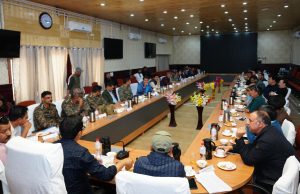𝐙𝐞𝐫𝐨 𝐓𝐨𝐥𝐞𝐫𝐚𝐧𝐜𝐞 𝐭𝐨 𝐰𝐚𝐬𝐭𝐞 𝐃𝐮𝐦𝐩𝐢𝐧𝐠 𝐢𝐧 𝐚𝐧𝐝 𝐚𝐫𝐨𝐮𝐧𝐝 𝐭𝐡𝐞 𝐒𝐚𝐜𝐫𝐞𝐝 𝐈𝐧𝐝𝐮𝐬 𝐑𝐢𝐯𝐞𝐫

𝐙𝐞𝐫𝐨 𝐓𝐨𝐥𝐞𝐫𝐚𝐧𝐜𝐞 𝐭𝐨 𝐰𝐚𝐬𝐭𝐞 𝐃𝐮𝐦𝐩𝐢𝐧𝐠 𝐢𝐧 𝐚𝐧𝐝 𝐚𝐫𝐨𝐮𝐧𝐝 𝐭𝐡𝐞 𝐒𝐚𝐜𝐫𝐞𝐝 𝐈𝐧𝐝𝐮𝐬 𝐑𝐢𝐯𝐞𝐫: 𝐇𝐨𝐧’𝐛𝐥𝐞 𝐂𝐄𝐂 𝐋𝐞𝐡 𝐑𝐚𝐥𝐥𝐢𝐞𝐬 𝐒𝐭𝐚𝐤𝐞𝐡𝐨𝐥𝐝𝐞𝐫𝐬 𝐟𝐨𝐫 𝐌𝐢𝐬𝐬𝐢𝐨𝐧 𝐈𝐧𝐝𝐮𝐬 𝐂𝐥𝐞𝐚𝐧-𝐔𝐩
Leh, June 18:
In a strong and urgent call for an aggressive Indus river and adjoing area clean up, the Hon’ble Chairman/CEC of LAHDC Leh, Adv. Tashi Gyalson, chaired a high-level meeting of key stakeholders to lend their support to the mission-mode clean-up campaign aimed at enforcing zero tolerance against pollution in the sacred Indus River.
The meeting, held at the Conference Hall of the DC’s Office, was attended by Hon’ble EC Sh. Ghulam Mehdi and LoP Sh. Tsering Namgyal, along with Hon’ble Councillors Sh. Lobzang Sherab, Sh. Stanzin Chosfail, Sh. Tundup Norbu, Dr. Morup Dorjey, Sh. Ishey Spalzang, Sh. Thinles Nurboo and Sh. Sonam Thardos. Key officials present included Sh. Sajjad Hussain Mufti, Chief Wildlife Warden, and Sh. Ghulam Mohammad, ADC, Leh.
From the Indian Army, Lt. Col. P.S. Bisht (SM), ADM COMDT STN HQ Leh; Lt. Col. Dhawal from HQ CE (P) HIMANK; Col. C. Paul, ADM COMDT STN HQ 3 INF Kharu; and Col. S. S. Aulakh, ADM COMDT STN HQ Kiari, participated in the meeting. The ITBP was represented by DIG K.S. Rawat.
Also present were SDMs of Likir and Kharu; Dy.SP HQ Leh, Sonam Angchuk; Tehsildars of Leh and Nyoma; Executive Engineer of Igoo/Phey; and the District Officer of the PCC, Leh among others to address the alarming pollution levels in and around the Indus River.
Representatives from civil society and major associations also participated, including Presidents of Christian Association, Anjuman Moin-ul-Islam, ALGHA, ALTA, ALTOA, LTTA, Merchant Associations.
Stressing the cultural, religious, and ecological significance of the Indus River—revered and relied upon by generations—Hon’ble CEC Tashi Gyalson expressed grave concern over the increasing pollution caused by garbage dumping and the release of untreated sewage into the river. “This river is not just a water body. It is sacred. It is worshipped, and it sustains lives. We cannot stand by as it turns into a dumping ground,” he said.
A recent water test revealed the disturbing presence of arsenic levels in the Indus being higher than those found in treated sewage plant discharge, prompting the H’CEC to describe the situation as “deeply concerning and unacceptable.” He called for immediate and coordinated action from all stakeholders, including Councillors, Nambardars, the Municipal Committee, rural and urban development bodies, and citizens.
To ensure sustained monitoring and enforcement, the Hon’ble CEC directed the ADC Leh for formation of a Flying Squad at sub-division level to identify and curb illegal dumping activities along vulnerable stretches of the river.
He further directed the ADC Leh to constitute a District-Level Committee, chaired by the Hon’ble CEC, comprising representatives from the army, paramilitary forces, BRO, Nambardars, Ex-Sarpanch/ Panch and government officials. The committee will be responsible for overseeing ongoing interventions, reviewing progress, and formulating future strategies.
He also directed the CWLW, Sh. Sajjad Mufti, to identify and specify relevant bylaws aimed at safeguarding the fragile environment of Ladakh—particularly under the Water (Prevention and Control of Pollution) Act, 1974, administered by the CPCB or any other extant laws—for imposing stringent penalties on violators and for ensuring accountability.
As a decisive first step to rejuvenate the Indus, the meeting resolved to initiate a large-scale, community-driven cleanliness campaign. The drive will actively involve the army, paramilitary forces, BRO and local stakeholders.
The Hon’ble CEC also decided to hold a high-level meeting with the Army, Paramilitary, and BRO to devise targeted strategies for the protection of the Indus River.
He further proposed a follow-up meeting with the UT Administration to discuss the formulation of effective bylaws and enforcement mechanisms for imposing penalties on violations.


